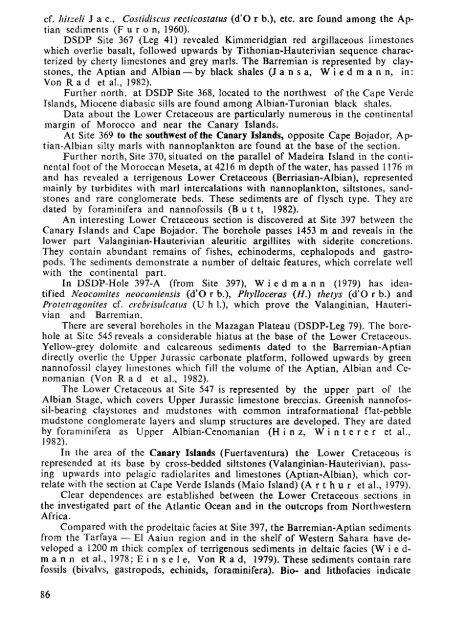THE MEDITERRANEAN LOWER CRETACEOUS
THE MEDITERRANEAN LOWER CRETACEOUS
THE MEDITERRANEAN LOWER CRETACEOUS
Create successful ePaper yourself
Turn your PDF publications into a flip-book with our unique Google optimized e-Paper software.
cf. hitzeli J a c, Costidiscus recticoslatus (d'O r b.), etc. are found among the Aptian<br />
sediments (F u r о n, 1960).<br />
DSDP Site 367 (Leg 41) revealed Kimmeridgian red argillaceous limestones<br />
which overlie basalt, followed upwards by Tithonian-Hauterivian sequence characterized<br />
by cherty limestones and grey marls. The Barremian is represented by claystones,<br />
the Aptian and Albian — by black shales (J a n s a, W i e d m a n n, in:<br />
Von R a d et al., 1982).<br />
Further north, at DSDP Site 368, located to the northwest of the Cape Verde<br />
Islands, Miocene diabasic sills are found among Albian-Turonian black shales.<br />
Data about the Lower Cretaceous are particularly numerous in the continental<br />
margin of Morocco and near the Canary Islands.<br />
At Site 369 to the southwest of the Canary Islands, opposite Cape Bojador, Aptian-Albian<br />
silty marls with nannoplankton are found at the base of the section.<br />
Further north, Site 370, situated on the parallel of Madeira Island in the continental<br />
foot of the Moroccan Meseta, at 4216 m depth of the water, has passed 1176 m<br />
and has revealed a terrigenous Lower Cretaceous (Berriasian-Albian), represented<br />
mainly by turbidites with marl intercalations with nannoplankton, siltstones, sandstones<br />
and rare conglomerate beds. These sediments are of flysch type. They are<br />
dated by foraminifera and nannofossils (Butt, 1982).<br />
An interesting Lower Cretaceous section is discovered at Site 397 between the<br />
Canary Islands and Cape Bojador. The borehole passes 1453 m and reveals in the<br />
lower part Valanginian-Hauterivian aleuritic argillites with siderite concretions.<br />
They contain abundant remains of fishes, echinoderms, cephalopods and gastropods.<br />
The sediments demonstrate a number of deltaic features, which correlate well<br />
with the continental part.<br />
In DSDP-Hole 397-A (from Site 397), Wiedmann (1979) has identified<br />
Neocomites neocomiensis (d'O г b.), Phylloceras (H.) thetys (d'O г b.) and<br />
Protetragonites cf. crebrisidcatus (U h I.), which prove the Valanginian, Hauterivian<br />
and Barremian.<br />
There are several boreholes in the Mazagan Plateau (DSDP-Leg 79). The borehole<br />
at Site 545 reveals a considerable hiatus at the base of the Lower Cretaceous.<br />
Yellow-grey dolomite and calcareous sediments dated to the Barremian-Aptian<br />
directly overlie the Upper Jurassic carbonate platform, followed upwards by green<br />
nannofossil clayey limestones which fill the volume of the Aptian, Albian and Cenomanian<br />
(Von Rad et al., 1982).<br />
The Lower Cretaceous at Site 547 is represented by the upper part of the<br />
Albian Stage, which covers Upper Jurassic limestone breccias. Greenish nannofossil-bearing<br />
claystones and mudstones with common intraformational flat-pebble<br />
mudstone conglomerate layers and slump structures are developed. They are dated<br />
by foraminifera as Upper Albian-Cenomanian (H i n z, Winterer et al.,<br />
1982).<br />
In the area of the Canary Islands (Fuertaventura) the Lower Cretaceous is<br />
represended at its base by cross-bedded siltstones (Vaianginian-Hauterivian), passing<br />
upwards into pelagic radiolarites and limestones (Aptian-Albian), which correlate<br />
with the section at Cape Verde Islands (Maio Island) (Arthur et al., 1979).<br />
Clear dependences are established between the Lower Cretaceous sections in<br />
the investigated part of the Atlantic Ocean and in the outcrops from Northwestern<br />
Africa.<br />
Compared with the prodeltaic facies at Site 397, the Barremian-Aptian sediments<br />
from the Tarfaya — El Aaiun region and in the shelf of Western Sahara have developed<br />
a 1200 m thick complex of terrigenous sediments in deltaic facies (W i e dm<br />
a n n et al., 1978; E i n s e 1 e, Von Rad, 1979). These sediments contain rare<br />
fossils (bivalvs, gastropods, echinids, foraminifera). Bio- and lithofacies indicate<br />
86

















